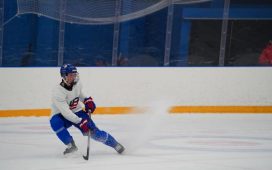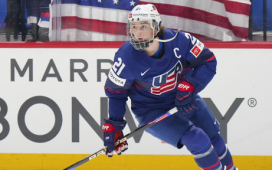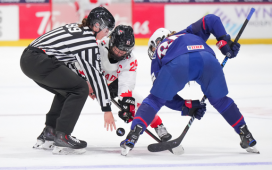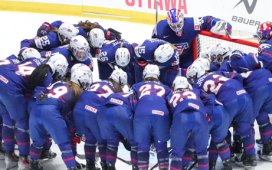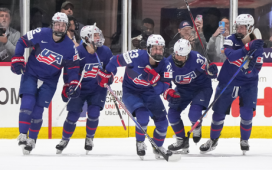Cale Makar is the Calder Trophy frontrunner. There’s no questioning that, not even for a second. He’s been the lead dog of the freshman class since early in the campaign, the result of his bursting out of the gate with 22 points through his first 20 regular season NHL contests. Thus, when The Hockey News compiled its mid-season awards, it was no surprise to see Makar at the top of the list. Likewise, when the Professional Hockey Writers Association named its mid-season award winners entering the all-star break, few batted an eye at Makar’s first-place finish in Calder voting.
Notable about Makar’s mid-season victories, be it around these parts or in PHWA voting, is how sweeping they were. In our office, Makar captured every first-place nod. He received all nine votes as the NHL’s top rookie. And while it wasn’t unanimous, the PHWA voting was as decisive. As PHWA president Frank Seravalli noted after the winners were revealed, Makar was a “landslide” victor, earning 101 first-place votes.
The reasons for Makar’s clear-cut victory are obvious enough. He’s stepped in to become a top-pairing blueliner overnight, is producing at a rate we haven’t seen from a rookie rearguard since Brian Leetch and Larry Murphy dazzled with their first-year performances in the 1980s and the Avalanche blueliner one of the driving offensive forces on a Colorado club that’s fighting for top spot in the Central Division. The feathers in his cap are plentiful.
But is the gap between Makar and the next-best rookie really that large?
To be clear, when we say next-best rookie, we’re not talking about the Buffalo Sabres’ Victor Olofsson or Chicago Blackhawks’ Dominik Kubalik. Despite how eye-opening his performance has been, we’re not referring to Pittsburgh Penguins defenseman John Marino, either. No, if Makar has one challenger – and barring any unforeseen circumstances, he does have one and one alone – it’s Vancouver Canucks defenseman Quinn Hughes, who received 11 first-place Calder votes and finished second in the PHWA’s mid-season polling.
Offensively, the spread between Makar and Hughes is nowhere near as large as it was across those first 20 games when eight points separated the two blueliners. In fact, following Hughes’ two-point night in the Canucks’ Wednesday win, the once-chasm has been narrowed to a single point, Makar leading all freshmen with 37 points and Hughes right on his heels with 36 points of his own. By measure of per-game production, however, the two aren’t all that close. Makar, who missed time and has played nine fewer games, is producing at 0.9 points per game. Hughes is nearly one-fifth of a point per game behind at .72. Makar (22) is also outpacing Hughes (18) in even-strength points, though Hughes (18) has made up some ground on Makar (15) by way of power-play production.
What the raw offensive numbers fail to take into account, though, is the impact either player has actually had on tilting the ice in the favor of their respective clubs, and that might be where Hughes makes up the most ground on Makar and has potential to start to swing some voters in the back half of the campaign.
At five-a-side, Makar is no slouch. He’s a positive possession player, the Avalanche have excellent scoring chance and high-danger chance percentages and an expected goals percentage of 53.2 percent with the rookie blueliner on the ice. But Hughes’ numbers are arguably better, particularly when taking into account Vancouver’s mediocre overall underlying numbers in comparison to the above-average Colorado boasts, and his 53.7 expected goals percentage is significant when considering the Canucks’ team total at 5-on-5 is a mere 48 percent.
Though not a measure without its flaws, Hughes’ numbers relative to his teammates are worth noting, as well. He has a relative Corsi percentage of 6.5 percent, shots percentages of 5.9 percent and expected goals for percentage of 9.1. By comparison, Makar has percentages of minus-0.2, 2.4 and 2.9 in the respective categories. Hughes’ relative goals for percentage is also a healthy 5.2 percent, much better than Makar’s minus-1.9 percent. Again, relative statistics aren’t without their flaws and should be taken with a grain of salt, but they do further illustrate what the eye test has seemingly told us about Hughes all season long: he’s every bit the top-pairing blueliner that Makar has been.
Hughes has certainly skated the minutes to support his status as a No. 1 blueliner, too. At an average of 21:33 per game, nearly a full minute higher than Makar’s 20:37 average, Hughes ranks third in ice time among Canucks rearguards and he’s only taken on greater responsibility as the season has worn on. Since Dec. 1, Hughes is nine seconds shy of a 23-minute average, the highest of any Vancouver defender, and is leading all Canucks blueliners in even strength and power play ice time. He also ranks 34th in average ice time among all NHL defensemen since Dec. 1 and 44th in average even-strength ice time. By comparison, Makar ranks 65th and 79th in the respective categories, though he’s played nine games fewer. Any way you slice it, though, Hughes has been tasked with bigger minutes than Makar, and the underlying numbers suggest the former has done more to drive play for his team than the latter.
All of this is to say that there are myriad factors that should come into play when it comes to deciding which of the defensemen is most worthy of earning the Calder, but the reality is that voting will likely come down to simple offensive output. And despite the fact both Makar and Hughes are on pace to become the 10th and 11th rookie rearguards in NHL history and quite possibly two of only eight to score 61 or more points, that means Hughes’ best and possibly only chance at closing the gap and truly swaying voters to consider him Makar’s equal is to start piling up the points.
(All advanced statistics via NaturalStatTrick)
Want more in-depth features, analysis and an All-Access pass to the latest content? Subscribe to The Hockey News magazine.
